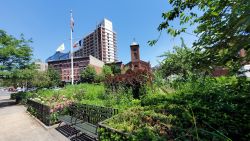Roosevelt Triangle
Roosevelt Triangle
Acquired and dedicated in 1941, this park is named for Franklin Delano Roosevelt (1882-1945), the 32nd President of the United States, who led the country through the Great Depression and World War II. Like his distant cousin Theodore Roosevelt (1858-1919), he received a Harvard education and became an active participant in New York State politics before becoming a national figure. Roosevelt was elected President in 1932 and was reelected three times, serving until his death—a tenure longer than that of any other US President.
FDR, as Roosevelt is popularly known, created a comprehensive network of social services under the designation “The New Deal.” The program helped to revitalize the depressed national economy and many of its initiatives, such as the Social Security Administration and the Federal Communications Commission, which remain in operation. As well as his expansive social policies, Roosevelt’s assured bearing brought confidence to the distressed public. Although he was unable to walk unassisted because of a debilitating attack of polio he had suffered in 1921, FDR was careful to present himself as a hale and jaunty optimist who was seldom seen without a grin. The President was one of the first national leaders to use the radio as a means of establishing a rapport with the American public. Among his many inspiring pronouncements, the most enduring is from Roosevelt’s first inaugural address: “The only thing we have to fear is fear itself.”
A World War I American AMSCO tank occupied Roosevelt Triangle until 1942 when it was removed along with military artillery displayed in many other small park triangles, and salvaged as material to support the war effort during World War II. The bronze sculpture that now stands in Roosevelt Triangle was donated by the Peter Putnam-Mildred Andrews Fund in 1976. This abstract piece, Harlem Hybrid, is the work of Richard Hunt and is constructed from welded bronze plate. Hunt is an African American artist with an international reputation. He has produced a number of public sculptures, most in his native Chicago, in a career that has spanned over thirty years. In New York, Hunt has exhibited his work at the Museum of Modern Art and the Studio Museum of Harlem. Although Hunt’s work is purely abstract and usually executed in metal or discarded machine-made parts, admirers find consistent evocations of plant life and geological formations in his work.
In September 2000, Parks completed an extensive renovation of the triangle that include new sidewalks, benches, a steel fence, and a plethora of new plant life. A few trees and 354 shrubs were planted including Crimson Pygmy, Rockspray Cotoneaster, and Shrubby Cinquefoil. Harlem Hybrid, which illustrates Hunt’s tendency to take inspiration from nature, is perfectly suited to nestle among the trees in this small public plot dedicated to the memory of a New Yorker of great distinction.
Check out your park's Vital Signs
Clean & Safe
Green & Resilient
Empowered & Engaged Users
Share your feedback or learn more about how this park is part of a
Vital Park System







